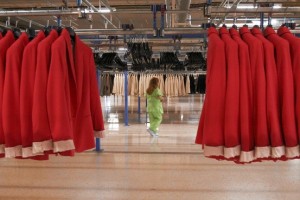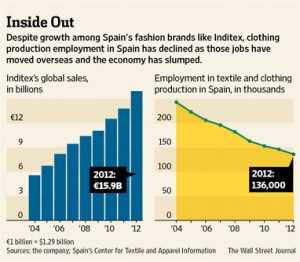 Reuters
Reuters
Spain’s textile industry is suffering, and garment-factory outsourcing
has been marred by accidents. Above, a Zara factory in northern Spain.
Homegrown Spanish fashion brands like Zara and Mango have been rare success stories in Spain amid its wrenching economic depression. But now a series of deadly accidents at overseas sewing plants are causing some soul-searching about the cost of looking good—especially at a time when Spain’s own textile industry has been hollowed out by imports and outsourcing, while Spain’s consumers are increasingly too impoverished to afford new clothing.
In the rubble of the collapsed Rana Plaza building in Dhaka, Bangladesh, where more than 1,100 garment workers died last month, investigators found order forms or clothing from Barcelona-based Mango MNG Holding SL and Spanish department store chain El Corte Inglés SA. A Spaniard, David Mayor, whose location is unknown, is listed on corporate registries as the director general of one Rana Plaza factory. Inditex SA, owner of the Zara brand and the world’s largest fashion retailer, was a customer of the Smart Export factory near Dhaka, where seven workers died in a fire in January.
The accidents have triggered questioning about the costs of “fast fashion,” a design trend pioneered by Spanish labels that relentlessly rotate collections to keep new styles on store racks. That quick-turnaround strategy has helped transform Inditex from a business started in a garage in the 1960s to a global force whose founder, Amancio Ortega, is now one of the world’s richest men.
Some Spanish union leaders say the success of Spanish style has done more for corporate shareholders and foreign consumers than for workers at home or abroad. “It’s very simple: They moved a lot of jobs to low-wage countries with lower work standards and now you are seeing accidents as a result,” said Montserrat López García de la Torre, secretary of international relations at Spain’s General Union of Workers.
The other side of the coin, she said, is Spain’s five-year-old economic downturn and 27% unemployment rate. The decline in its textile and apparel industries, where employment has fallen to 136,000 from 243,000 in 2004, preceded the country’s broader troubles, as Asian imports started supplanting local production. From 2002 to 2011, around 7,000 Spanish textile or clothing companies, about 43% of the total, closed their doors, a study by Spain’s EAE Business School found.
The global success of Spain’s flagship fashion companies presents a paradox. In the past decade, Inditex’s global sales have grown fourfold to nearly €16 billion ($20.65 billion) in 2012. Meanwhile, the recession at home slashed Spaniards’ per-capita spending on clothing by 22% between 2007 to 2011, the EAE Business School study found.
Some analysts argue that fast-fashion purveyors are the last people to be blamed for Spain’s economic malaise or the malaise in the local textile industry. “Fast fashion depends heavily upon producing close to home,” said Angel Asensio, the head of Spanish Federation of Clothing Manufacturers. The idea, he said, is to cut down the time it takes to get merchandise from the plant to design and distribution centers located in Spain.
Inditex, for instance, said that about half of its total production comes from Spain and nearby countries such as Portugal and Morocco. The number of Inditex employees in Spain increased by 46% to 39,098 in the seven years to 2011, though most jobs are in retail, logistics or administration, with only about 1,100 posts in company-owned plants.
Inditex also has 6,500 Spanish suppliers, which booked sales of €3 billion to the fashion giant last year.
About 6% of Inditex’s merchandise comes from Bangladesh, a share that hasn’t changed significantly in recent years, the company says. About 4% of Mango’s 2011 purchases came from Bangladesh, compared with 0.64% in 2007, the company has reported. Bangladesh produces “very basic, low cost products for clothing companies all over the world”—not fast fashion, said Mr. Asensio.
Perhaps. But Mahmudul Islam, commercial counselor in Bangladesh’s embassy in Madrid, said that Bangladesh takes pride in the fact that it is moving up the value-added chain and turning out more sophisticated denim and knit products, including stylish jeans for Zara’s youth-oriented Trafaluc line.
Plant-safety specialists say that companies have to be sensitive to the strain that fast fashion can cause between producing safely and producing quickly.
“You can’t have the corporate-responsibility department saying that factory overtime hours have to be kept at reasonable levels and then the purchasing department demanding 10,000 pink blouses delivered in a week,” said Macarena Gross, who heads corporate social responsibility for Hoss Intropia, a smaller Spanish label.
Ms. Gross said she has had to use videos and photographs about living and working conditions in India, where the company makes some clothing, to raise awareness in the corporate offices in Madrid. “You’d be amazed at how little is known within a fashion company about the places where clothes are actually sewn,” she said.
Inditex says it nearly doubled to almost 2,000 the number of internal and external workers focused on what it terms “sustainability” issues between 2010 and 2011. But that hasn’t eliminated safety lapses.
In the case of the Smart Export fire, Inditex said, a contractor had subcontracted some work to the factory in Bangladesh, where, according to workers, the emergency exit was locked at the time of the blaze. In a 2011 case, an Inditex contractor in Brazil subcontracted work to another garment maker that Brazil’s government alleged kept Bolivian immigrant workers in sweatshop conditions. Inditex said it broke ties with the contractors in both cases and saw to it that workers were indemnified.
Maintaining oversight of the entire production chain often means “having to track down the subcontractor of the subcontractor of the subcontractor,” said José Luis Nueno, a marketing professor at Spain’s IESE Business School. Mr. Nueno gave Inditex high marks, but added that the task can get complicated when a company is producing the volume Inditex does—nearly a billion garments last year.
Inditex, Mango and El Corte Inglés are among several European retailers that signed a legally binding agreement to improve safety in Bangladesh plants following the Rana Plaza collapse.
Some union leaders called on the companies to take further steps toward transparency, by following the example of sneaker makers such as Nike and Adidas, which divulge the names of their overseas suppliers. “There are still gaps in what fashion companies report,” said José Mesa, a secretary at the General Union of Workers. Inditex said government and union officials in countries where it operates know full well the identity of its local producers.
Until an economic recovery lifts the national mood, Spaniards may continue to be wary of embracing the international success of Inditex’s Mr. Ortega, who was ranked third on the Forbes billionaires list, with a net worth of $57 billion.
When Mr. Ortega donated €20 million to the Catholic charity Caritas last October, fierce disputes broke out on Twitter and Facebook between those Spaniards who praised his generosity and others who questioned whether the gift was tainted. Novelist Lucía Etxebarría wrote on her Facebook page that she “had worn Zara almost exclusively,” but stopped after reading about poor conditions in Asian plants and “the bad salary conditions of textile workers.”
A sportscaster, Sergio Sauca, was one of several celebrities who leapt to Mr. Ortega’s defense. “What a pitiful country,” he tweeted. “Amancio Ortega donates 20 million to Caritas and is criticized. What envy. In other places they’d build a monument to him.”
Article published by Matt Moffett in The Wall Street Journal. May 23, 2013
http://online.wsj.com/article/SB10001424127887323336104578500961122418382.html




